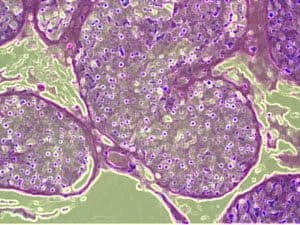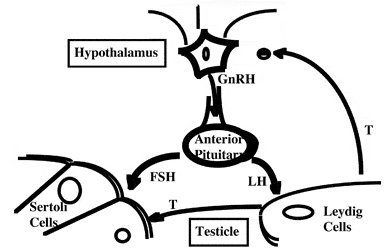How To Create Sperm In Human Body
Spermatogenesis | The Turek Clinic
Male Spermatogenesis

Sperm production is hormonally driven. Brain hormones govern sperm production and are precisely controlled. Themale genitalia are responsible for sperm and ejaculate production. Within the brain, thehypothalamus and anterior pituitary control sperm production. The hypothalamus secretes gonadotropin-releasing hormone (GnRH), which acts on the anterior pituitary gland, stimulating it to release follicle stimulating hormone (FSH) and leutinizing hormone (LH). FSH and LH are released into the bloodstream and act only on the testes to encourage spermatogenesis within seminiferous tubules (action of FSH) and testosterone production by neighboring Leydig cells (action of LH) between the seminiferous tubules (Figure 1).Normal hormone balance is important for normal sperm production and these hormones are often measured as part of the infertility evaluation.
Human Sperm Production
Sperm Production Process

The male genitalia consist of the scrotum, which houses the testicles and associated ducts (the epididymis and vas deferens), and the penis (Figure 2). The testes are covered by a tough, white, fibrous layer called the tunica albuginea, which extends inward and divides the testis into 200 to 300 lobules. Sperm production occurs in the long and tightly coiled seminiferous tubules that are located in each of these lobules. Sertoli cells line the seminiferous tubules and serve as nurse cells to provide essential nutrients to sperm.In the absence of spermatogenesis, only Sertoli cells are seen on microscopic inspection of a testicular biopsy. Another important cell type within the testis areLeydig cells, which make testosterone, the essential male hormone. Testosterone is responsible for normal male secondary sex characteristic development, libido or sex drive and normal erections. Testosterone is also important for sperm production, as levels of this hormone are 50 fold higher within the testis as in the blood.
How Sperm Are Made
Within the adult testicle, there is 700 feet of tubing, termed seminiferous tubules, within which sperm is made. Sperm is made from precursor cells termed germ cells that give rise to approximately 120 million sperm daily in a process termed spermatogenesis that takes approximately 64 days in humans. This is equivalent to making about 1200 sperm per heartbeat. Within the seminiferous tubule, germ cells are arranged in a highly ordered sequence from outside to inside. Lining the tubules, there are adult testis stem cells that begin the process of sperm production. Overall there are 13 recognizable germ cell types in the human testis: dark type A spermatogonia (Ad); pale type A spermatogonia (Ap); type B spermatogonia (B); preleptotene (R), leptotene (L), zygotene (z) and pachytene primary spermatocytes (p); secondary spermatocytes (II); and Sa, Sb, Sc, Sd1, and Sd2 spermatids. Despite the high volume production of sperm, quality control checkpoints exist throughout the sperm production process to ensure the biological and genetic integrity of ejaculated sperm.

It has long been believed that sperm take 90 days (3 months) to be made and ejaculated. Dr. Turek recently discovered and published that in fact this time frame is actually much shorter.Sperm develop in the testicles for 50-60 days and are then excreted into the coiled ducts of the epididymis and complete their maturationfor another 14 days. Sperm waiting to be ejaculated remain in the epididymis, near the bottom of the scrotum. At ejaculation, sperm are propelled through the vas deferens within the spermatic cord and into the abdominal cavity and join the seminal vesicles, which add alkaline fluid that helps to support sperm. The ejaculate consists of fluid from 3 sources: the vas deferens (sperm fraction), the seminal vesicles, and the prostate. The seminal vesicle fluid makes 80% of the total semen volume, the vas deferens 10% and the prostate gland another 10%. This mixture of semen then exits the penis during ejaculation.
What is a Sperm?
The spermatozoon is a remarkably complex metabolic, locomotive and genetic machine. It is approximately 60 microns in length and is divided into 3 sections: head, neck and tail. The oval sperm head consists of a nucleus containing the highly compacted DNA, and an acrosome that contains the enzymes required for penetration of the egg shell for fertilization. The neck maintains the connection between the sperm head and tail and consists of the connecting piece and proximal centriole. The tail harbors the midpiece, principle piece and endpiece. The tail midpiece contains the axoneme or engine of the sperm and the mitochondrial sheath, the source of energy for movement. Physiologically, the sperm axoneme is the true motor assembly and requires 200-300 proteins to function. Among these, the microtubules are the best-understood components. Sperm microtubules are arranged in the classic "9+2" pattern of 9 outer doublets encircling an inner central doublet. Defects in the sperm axoneme are well-recognized causes of ciliary dyskinesias that are routinely associated with infertility.
Dr. Turek's Blog On Men's Health
Award-winning urologist and men's health pioneer Dr. Paul Turek authors Turek on Men's Health, named one of Healthline's top men's health blogs (2016 to present) and one of the Top 30 Men's Health Blogs (2017). The blog covers the gamut of men's health issues, from infertility to hormones to vasectomy reversal.
How To Create Sperm In Human Body
Source: https://www.theturekclinic.com/male-spermatogenesis/
Posted by: belltrainge.blogspot.com

0 Response to "How To Create Sperm In Human Body"
Post a Comment